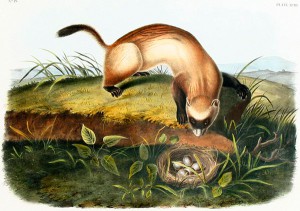Lesson Overview

Students will classify animals into the basic groups and become familiar with artworks. Students will create their own artwork of their favorite animal. Students should have some background knowledge of living things and animals including the basic types of animal groups (vertebrates/invertebrates, mammals, birds, reptiles, fish, and amphibians).
Lesson Objectives:
Students will apply their knowledge of animal groups and their habitats by identifying the external parts of plants and animals.
Students will create an artwork of their favorite animal in its natural habitat.
Instructional Procedures/Sequence:
- Teach students the difference between vertebrates and invertebrates. Explain that the group of vertebrates can be broken into smaller groups (mammals, birds, reptiles, fish, and amphibians). Discuss the unique features of each group and why these animals are classified this way.
- Students will make a card for each group. On one side they will write the name of the group (mammals, birds, reptiles, fish, or amphibians). On the reverse side, they will write features of that group (e.g., breathe with lungs/gills, warm/cold blooded, etc.).
- Give students an preview/overview lesson. Tell students they will pretend to be scientists working in a museum and will have to classify animals for an exhibit. Tell students their “specimens” will be included in artworks at MONA and they will learn about each artwork before they classify the type of animal. Next, they will look at each “specimen,” think about the features of the animal, and using the information on their cards, decide which group it belongs in. When prompted by the teacher, they will hold up the card with the name of the group the animal belongs in. The students will then discuss why they chose the group. When they have come to a consensus, they will record their answer on a recording sheet.
Vocabulary
vertebrate
invertebrate
mammal
bird
fish
reptile
amphibian
classify
Materials Needed:
Student word cards representing the five groups of vertebrates (mammal, bird, fish, reptile, and amphibian)
Students’ recording form
Posters of animal groups if available
Reaction paper rubric to evaluate students understanding of MONA lesson as it relates to the elements presented.
Standards Addressed:
- SC2.3.1.c Identify external parts of plants and animals.
- SC2.3.1.d Observe and match plants and animals to their distinct habitats.
- SC2.1.1.f Use drawings and words to describe and share observations with others.
Accommodations/Modifications:
Students with special needs should be evaluated by their teachers as to the accommodations that will work best for them.
Methods of Assessment:
Points for participation during activity can be awarded. Points can be given for completing worksheet and correctly classifying each animal.
A written test can be given at the conclusion of an animal unit if this lesson is part of a science unit on animals.
More Lesson Plans
Life as a Nebraska Pioneer – Collage Art, Third & Fourth grade
Native Americans on the Plains, History – Fourth grade
Fundamentals of Design through Art, Family Consumer Science – Secondary level









